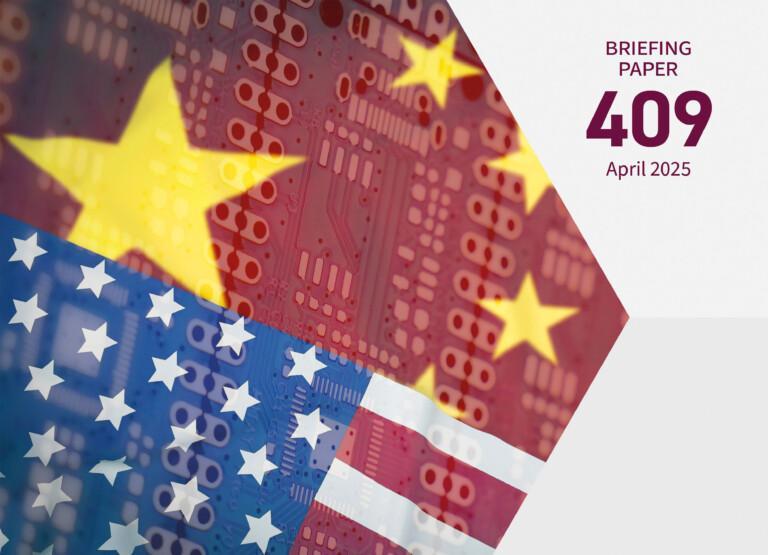
The International Criminal Court (ICC) and the Responsibility to Protect (RtoP) principle both seek to respond to mass atrocities. They are products of the heyday of the international liberal order, which allowed the formation of projects based upon interference in the internal affairs of states in order to protect populations from atrocity crimes. The changing international system with the redistribution of power between states has affected these projects by bringing uncontroversial activities to the fore in order to secure state acceptance.
Consensus on the RtoP extends to the primacy of the state in protection of its populations, while actions of the international community going beyond assistance and capacity-building are contested, particularly highly coercive ones such as military intervention.
Alongside its judicial task of trying perpetrators of international crimes, the ICC has focused on positive complementarity whereby national capabilities are enhanced. It has also engaged in symbolic activities, such as highlighting certain international crimes.
Introduction
In the early post-Cold War period two distinctive projects emerged aimed at addressing mass atrocities by making sovereignty conditional upon respect for the rights of all populations within the state. These global human rights projects comprised the creation of the permanent International Criminal Court (ICC) in 1998, and the development of the doctrine of the Responsibility to Protect (RtoP) in 2001, which was later to be universally accepted in the 2005 World Summit Outcome Document (WSOD). Despite broad acceptance and the ongoing work within both frameworks, it seems that the projects are facing harder times as they are intimately connected to geopolitics and normative contestation. The operationalization of the RtoP has been uneven, and the 2011 Libya intervention caused a fracture in support for the coercive side of the principle, which has affected dealings over the Syria conflict. Equally, the ICC has faced resistance and even a number of withdrawals, which challenges its promise of universality.
The aim of this Briefing Paper is to revisit the theme of international anti-atrocity interventionism by exploring the current standing of the ICC and the RtoP. This issue is topical for a number of reasons. First, in July 2018 it will be 20 years since the acceptance of the Rome Statute, which motivates an analysis of the Court. Second, great-power politics is increasingly shifting towards the rejection of interventionist policies, especially with the rise of China, but also due to uncertainties plaguing US conduct with the Donald Trump administration. Third, there is constant debate about how to address the ongoing atrocities in Syria and other protracted conflicts.
As a first step, this Briefing Paper will present a short sketch of the aim of both projects, after which the main criticism levelled against them will be discussed. This will be followed by an examination of the recalibration of the doctrines, arguing that there has been a shift to less controversial activities within the respective domains in order to manage the critique. The whole analysis will be instructed by the changing international system, with the West in relative decline and other parts of the world in the ascendant.
The endeavour to apoliticize interventionism
The question of how to deal with mass atrocities has always challenged the international community, and the 1990s provided several opportunities to contemplate the issue. The Kosovo military intervention in 1999 by NATO member states represented a turning point, as international reactions to massacres before that had focused mainly on the aftermath of the conflicts by establishing international criminal tribunals in order to bring the perpetrators to justice.
In parallel with the process of international criminal justice, which culminated in the establishment of the ICC in 1998, a Canadian initiative set out to explore, inter alia, when states should be allowed to take coercive action against other states on humanitarian grounds. This effort resulted in the 2001 Report on the Responsibility to Protect by the International Commission on Intervention and State Sovereignty (ICISS), and the principle was subsequently adopted in a modified version with consensus by UN states in the 2005 WSOD. The doctrine was further elaborated in the 2009 UN Secretary-General Report on the Implementation of Responsibility to Protect, which identified three pillars of the RtoP, namely 1) the protection responsibilities of the state, 2) international assistance and capacity-building, and 3) timely and decisive response, which foresaw the possibility of military intervention as a last resort.
The RtoP and international criminal justice as embodied in the ICC share the idea that atrocity crime must be responded to in one way or another – be that prevention, protection or prosecution. The doctrines complement each other and are expected to work together; the ICC has been called the legal arm of the RtoP. They share a similar construction, according to which the primary responsibility for addressing mass atrocities lies with the state, and only if the state fails can the international community take coercive action as a last resort. What is more, both projects are confined to situations involving a limited number of international crimes, such as crimes against humanity, genocide and war crimes.
Intervention on human protection grounds has been contentious both when it has taken place and when it has not. This so-called intervention dilemma led to efforts to make the determination of intervention as free from politics as possible. One of the explicit objectives of the original formulation of the Responsibility to Protect in the ICISS report was ‘to establish clearer rules, procedures and criteria for determining whether, when and how to intervene’. Similarly, the ICC has been described as an institution that is and should be resistant to politics because of its legal character. But stripping politics away from interventionism on human protection grounds has nonetheless been an endeavour doomed to fail, and much of the criticism expressed against the RtoP and the ICC is directly related to politics. In the following section, criticism that has been levelled against both projects will be examined.
Principled and practical objections
The resurgence of classic state sovereignty
Global power shifts, as well as domestic ones, have left the international human rights regime struggling as the nascent multipolar world order is characterized by the rise of states that have not been strong supporters of the human rights project. A sceptical perspective on human rights is gaining ground with the resurgence of Russia and the rise of countries such as China, Turkey and the Philippines. Moreover, states that have traditionally defended the international liberal order, and human rights as a part of it, seem less willing to either talk the talk or walk the walk. Both the RtoP and the ICC were born in times of US hegemony, but President Trump seems less enthusiastic about atrocity prevention than his predecessor. The recent decision of his administration to withdraw from the UN Human Rights Council also raises some questions about the country’s commitment to human rights. Moreover, European countries suffer from decreasing support for the liberal values that the very same countries have participated in building up. For example, Denmark – a traditional human rights devotee – is seeking to reform the European Court of Human Rights in order to influence the Court’s allegedly too extensive human rights readings. It seems that in these critical times the doctrines of the RtoP and the ICC, both of which are interventionist in nature, ‘are not possible in the world as it actually exists’.[1]
Indeed, the norms entailing interventionism on human protection grounds are at the very far end of the international liberal order. They not only encroach upon the internal affairs of a state but also open the door for international actions, which is why it has been claimed that both projects stretched the liberal values too far, generating the current backlash.[2] The sovereigntist agenda is on the winning side again; prospective great powers such as China, Russia and India all agree on a classic interpretation of international law, which is founded on sovereignty, territorial integrity and consensuality. At the heart of this reading of international law are the UN Charter in particular and its principle of non-intervention, a norm which China and Russia as permanent members of the Security Council have fiercely supported in their (in)action on Syria, for example. Moreover, China, Russia and India have themselves been involved in conflicts that could be subject to judicial interventionism, which gives the states yet another reason to reject both the RtoP and the ICC.
Abuse potential
Another key concern with regard to both the RtoP and the ICC is the potential for abuse that both projects are considered to entail. A number of states, such as Egypt and Iran, claim that the RtoP can easily be employed for political purposes, or ultimately, according to Venezuela and Cuba, as a neo-imperialistic tool for regime change. Similar allegations have been made against the ICC, particularly by African states. But practice has shown that the danger of abuse is not limited to Western states, as Russia’s actions in Georgia in 2008 on behalf of South Ossetians demonstrated.
Sceptical states point out that the possibility of abuse is not only theoretical as both the ICC and the RtoP have led to regime change in practice. Libya has been used as a case in point as it shows how international actions under the slogan of the RtoP slowly turned into mission creep, the aim of which became the removal of Muammar Gaddafi from power despite the objections of many non-Western states. The same claim has been made with respect to the ICC. In particular, the development to indict heads of state, even sitting ones, brings the issue of regime change to the fore of international criminal justice. This was the case with the ICC’s indictment of Gaddafi and his son, but it also relates, for example, to Sudan’s President Omar Al-Bashir. Moreover, bringing a state leader to The Hague for criminal proceedings effectively removes his or her possibilities to rule the country, as was argued by Kenyan President Uhuru Kenyatta when he was on trial in The Hague.
Implementation challenges
Since the ICC and the RtoP contain coercive elements, they both suffer from the structure of the international order, in which enforcement is in the hands of states as there is no international police force, or other enforcement body. Non-cooperation of state parties has been a notable problem for the ICC, the consequences of which have, for example, resulted in decreased efficiency as several aspects of the Court’s work depend upon state cooperation. To illustrate, the Court relies on states to arrest and surrender indicted persons, to investigate and gather evidence, and to protect witnesses. For instance, Sudan’s President Al-Bashir has still not been apprehended despite the ICC’s first arrest warrant in March 2009.
The RtoP also suffers from problems relating to implementation. Since coercive action needs to be mandated by the UN Security Council (SC), the five permanent members of the SC will in practice decide on whether the RtoP is translated into action, and the increasing geopolitical rivalry makes such consensus even harder to achieve. The case of Syria has provided both China and Russia with ample opportunities to reject interventionism, not only as a matter of principle, but also due to operational difficulties that plague interventions. According to Russian and Chinese commentators, the West’s actions plunged Libya into chaos, not to mention the civilian casualties that the Libyan operation caused.[3] The risk is, according to opponents, that military interventions undertaken for humanitarian purposes actually do more harm to the populations than the original situation.
Doctrinal recalibration
Much of the criticism that has been levelled against the RtoP and the ICC relates to normative contestation and fundamentally different views about how power should be exercised in international relations. Some non-Western states see both projects as inherently Western and as part of the broader liberal agenda, despite the fact that the RtoP, for example, entails nothing new: most states already have obligations under international law to protect their populations. There seems to be genuine agreement only on the fact that the primary responsibility to protect the population resides with the state – irrespective of whether this is done through prosecution or other means. However, bringing the international community and its role into the equation already generates disagreement, not least in relation to the RtoP and actions resulting from it. While most states accept softer forms of international action including humanitarian assistance and capacity-building,[4] the option of military intervention as part of the protection toolbox is disputed, and its standing is getting weaker.[5]
What is notable, however, is the fact that some sceptical states have formulated alternative or complementary visions of both the RtoP and the ICC. Brazil launched its concept of Responsibility while Protecting (RwP) in 2011, and an influential Chinese scholar, Ruan Zongze, presented the idea of Responsible Protection (RP) in 2012, both of which seek to shift the focus away from military interventionism to more accountability for the international community’s actions. Correspondingly, the African states that have been critical of the ICC, or even withdrawn from the Court, have put forward the idea of an African Criminal Court. In other words, there are many states that are not rejectionists of the concepts as such, although they are sceptical about their implementation. Thus, the rising major powers, such as China, accept that there may be exceptional situations of humanitarian urgency that may require external intervention, and hence these countries are not trying to undo the consensus of the WSOD on the RtoP.[6]
Indeed, states have used their leverage to accomplish doctrinal shifts within both projects, even though it is clear that the development of the ICC as a judicial international institution with a clear judicial mandate is not as easy to change as that of the more fluid RtoP doctrine. The annual interactive RtoP dialogue before the UN General Assembly, as well as the UN Secretary-General’s annual reports on RtoP, have given states ample opportunities to express and debate their views on how the doctrine and its implementation should be shaped. When it comes to the ICC, the Assembly of State Parties (ASP) has provided a forum for venting concerns, also for those states that are not parties to the treaty but which possess observer status. For example, China – despite being a non-state party – is very keen to maintain the possibility for observer states to be able to partake in the long-term development of the Court.[7] A specific opportunity to discuss the Court and its mandate was also presented at the ICC review conference in Kampala in 2010.
All in all, the concerns of critical states have been heard over the years, and the RtoP doctrine in particular has proved to be flexible and has allowed for doctrinal recalibration, which has been crucial in the consensus-building process. As for the ICC as an institution with a set mandate, a similar level of adaptation to criticism is not possible, but there are also discernable tendencies to accommodation within the Court’s work. In the following section, the adaptation patterns within the RtoP and the ICC will be discussed separately.
The RtoP’s shift of focus to prevention
The controversial element in the RtoP, namely the possibility of operationalizing the doctrine through military intervention, has led to a shift to prevention among proponents of the doctrine. In fact, support for the preventative aspect of the RtoP remains strong among states from all regions of the world. This shift already occurred early on, but it has continued to this day – to such a degree, in fact, that there have even been proposals to remove the third pillar from the whole doctrine.
Whereas the RtoP in its 2001 version centred to a large extent on military intervention, both the 2005 WSOD version and 2009 UNSG Implementation Report shifted the focus back home, to the state itself, while toning down the resorting to military intervention aspect. These later versions limited the applicability of the principle to four crimes, and highlighted the role of the UN and its Charter. It was noted in Article 138 of the WSOD that ‘[e]ach individual State has the responsibility to protect its populations from genocide, war crimes, ethnic cleansing and crimes against humanity’. Preventive and pre-conflict measures were emphasized at the expense of collective coercive action, which could only be undertaken by the SC. As a consequence, one should perceive the RtoP as stressing the prevention side and the usage of non-coercive means of intervention, rather than focusing on military intervention.
The perception today is that there is firm consensus only on the preventive side, which necessitates an orientation on national work despite the fact that the WSOD also recognized the possibility of resorting to collective action through the Security Council. As has been noted: ‘R2P [RtoP] is first and foremost about what is done at the national level rather than proclaimed in speeches at the UN’.[8] The doctrine has shifted the focus from high politics and Security Council (in)action to national implementation measures. The latter include, for example, general strengthening of the rule of law and human rights as well as the operation of civil society, but also fighting radical extremism and segregation more generally. The foreign policy dimension includes, for example, investments in development policy, combating impunity, crisis management and mediation, to name but a few policy measures.
One concrete step taken in linking the doctrine to work at the national level was the creation of a network of national focal points in 2010. Sixty states from all regions of the world, in addition to the EU, now have a national focal point for the RtoP, whose mandate is, inter alia, to help develop national action plans, to raise awareness of the doctrine, to gather best practices, and to mainstream preventive actions into all governmental sectors. There are also regular network meetings where different topical themes affecting the doctrine are discussed. This demonstrates that an integral part of the RtoP today consists of thinking about atrocity prevention at home.
The increasing systemic role of the ICC
The ICC has been under pressure for most of its existence. The over-enthusiastic expectations that accompanied the birth of the Court have not materialized to the degree expected. Perpetrators of international crimes remain at large, and the Court’s attempts to go after the ‘big fish’ have not been successful. It has faced charges of ineffectiveness and selectivity. While the Court has tried to develop efficiency in the determination of cases, through both changes in its practice and rule amendments, it has shied away from increasing its case law exponentially in order to prove its relevance.
Instead, fully in line with its statute, the Court has endorsed national prosecutions and the aim to leave a lasting imprint on local communities. The Court’s policy on positive complementarity includes actively encouraging states and their judiciary to undertake their primary responsibility in these matters. In the capacity of its ‘catalyst function’ the Court has, for example, encouraged state parties to enact effective legislation, urged international institutions to support national justice systems, stimulated states to investigate and prosecute more generally, and threatened to take over prosecutions if national authorities fail to deliver.[9] Thus, the ICC has sought to remove obstacles that stand in the way of national criminal justice, which to a large degree requires capacity-building work. Accordingly, the Court has sought to increase its legitimacy in the same way as the RtoP doctrine, namely by ‘shifting from intervening against sovereignty to understanding its role as capacity-building’.[10] Intervention is thus used as a means to strengthen sovereignty.
The Court has also entertained a more symbolic function by raising global awareness of certain crimes. For example, the use of child soldiers, gender-based and sexual violence crimes, as well as crimes concerning cultural heritage destruction and land grabbing, not to mention environmental crimes, have been strategic priorities of the Court in recent years. This ‘re-branding of the Court’ has allowed it to shift attention away from contentious high-profile cases against heads of state to less contentious areas of international criminal justice.[11]
Conclusions
The RtoP doctrine and the ICC have come to embody the 1990s interventionist times, which partly explains the persistent objection to them by some non-Western states. Still, this image is outdated as doctrinal and institutional recalibration have taken place within both projects. The RtoP doctrine has turned to prevention and tried to shift the focus away from its interventionist side, which was always controversial to begin with. While it has been more difficult for the ICC to adapt to critique as it is a judicial institution with a clear mandate, some traces of adjustment are also visible therein, as the Court has accepted its symbolic status as a global court. The importance of national work has characterized both the RtoP and the ICC, which downplays the role of the international community in responding to atrocity crimes.
With the international order in flux, it is debated how to best assess the current standing of both institutions. Whereas some appraise the projects based on their performance in specific cases, others think that neither the RtoP nor the ICC should be measured on the basis of individual cases. Instead, progress made within their respective institutional frameworks should be highlighted. Yet the two should not be disconnected. It is neither sufficient nor credible if progress is made only in international fora as a matter of principle. There must at all times be efforts to close the gap between the rhetorical and practical protection of populations.
But the bigger picture must also be kept in mind: the international order is changing towards a multipolar world with concomitant geopolitical rivalry raising its head. Simultaneously, rising and resurgent powers are wedded to an agenda of Western norm contestation, the primary targets of which include the RtoP and the ICC. The protection of human rights is under broader attack, and neither project should make too many concessions as these may end up watering down the very purpose of the respective projects. Further efforts are needed by states that prioritize human protection in order to realize the proclaimed goals, while the rising powers must not shy away from partaking in the process of global norm shaping.
Endnotes
[1] David Rieff, ‘The End of Human Rights: Learning from the Failure of the Responsibility to Protect and the International Criminal Court’, Foreign Policy, 9 April 2018.
[2] Anthony Dworkin and Mark Leonard, ‘Can Europe Save the Liberal Order?’, ECFR Policy Brief May 2018, 6.
[3] Ruan Zongze, ‘Responsible Protection: Building A Safer World’, China Institute of International Studies, 15 June 2012, 5; Meeting Coverage UNGA/11764, 26 February 2016.
[4] Anne Orford, International Authority and the Responsibility to Protect (Cambridge University Press, 2011), 27.
[5] Monique Law, ‘R2P: Activating the International Community’s Responsibility to Protect by Shifting Focus Away from Collective Action by the Security Council Towards Early Warning and Prevention’, Vol. 8, The King’s Student Law Review (2017), 105.
[6] Rosemary Foot and Andrew Walter, China, The United States, and Global Order (Cambridge University Press, 2011), 50.
[7] Statement by the Chinese Observer Delegation at the General Debate in the 16th Session of the Assembly of State Parties to the Rome Statute of the ICC, 7 December 2017, 9.
[8] Martin Mennecke, Denmark and the Responsibility to Protect. How to Put Atrocity Prevention into Practice in Danish Foreign Policy, December 2017, 10.
[9] Christopher K. Hall, ‘Positive Complementarity in Action’ in Carsten Stahn and Mohamed M. El Zeidy (eds), The International Criminal Court and Complementarity: From Theory to Practice (Cambridge University Press, 2014), 1019.
[10] David Chandler, ‘Born Posthumously: Rethinking the Shared Characteristics of the ICC and R2P’, 21 Finnish Yearbook of International Law (2010), 12.
[11] Christine Schwobel, ‘The Re-branding of the International Criminal Court (And Why African States Are Not Falling For It)’, Opinio Juris, 31 October 2016.










